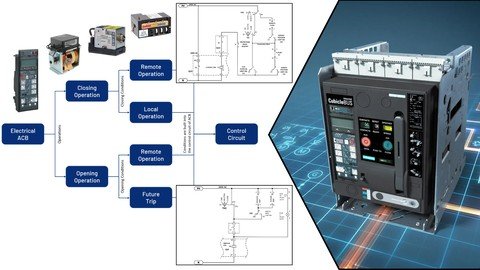Air Circuit Breaker And It’S Circuit Development

Free Download Air Circuit Breaker And It’S Circuit Development
Published 7/2024
MP4 | Video: h264, 1920×1080 | Audio: AAC, 44.1 KHz
Language: English | Size: 519.77 MB | Duration: 1h 34m
Learn about ACB’s and Develop its basic electrical circuit
What you’ll learn
Working principle of Air Circuit Breaker (ACB) , Technologies used in ACB for fault interruption (arc quenching).
Uses of ACB, Ratings & frame size of ACB, Types of ACB.
Fault breaking capacity & ACB’s technical specifications.
Methods of operating an ACB, Mechanism of manual & electrical ACB.
Working of Manual & Electrical ACB, Operation of closing & tripping coil of ACB.
Conversion of Manual ACB to Electrical ACB.
Releases of ACB, Importance & need of releases in ACB
Shunt Release, Undervoltage release, Thermal or Electromagnetic release of ACB.
Representation of schematic diagram of ACB (Power circuit, Closing circuit, Tripping circuit & Indication circuit).
Variation of supply control voltages used for control circuit of ACB, Distribution scheme of control supply of control circuit.
Position switch of ACB (Service position, Test position & Isolation position).
External protection relays used in ACB with release or without release.
How to create a basic schematic drawing of ACB (Power circuit scheme, Closing circuit scheme, Tripping circuit scheme, Indication circuit scheme).
Modification of the scheme diagram of ACB as per the logical condition.
Requirements
Should have a basic degree or knowledge in Electrical Engineering – B tech, B.E., Diploma or any similar relevant educational background.
Description
Air Circuit Breaker and it’s Circuit Development is a basic course to start learning about the widely and commonly used switchgear i.e. Air circuit breaker in LV systems, or to pursue knowledge for the selection of an ACB, Understand & Develop the basic circuits & electrical schematics or electrical drawing (power and control circuits) between the breaker & its various electrical components. In this course you can go through all details about Physical & technical parameters related to an ACB.We have thoroughly covered all the various concepts that are required to develop or build a Associated circuitry of the ACB & all the general information, knowledge and technical ideas required for the selection of ACB amongst OEMs.Some of the topics you will come across are:-Basic details of ACB – What is an ACB? Where is it used? What are the techniques used for fault interruption?ACB’s electrical specification, Frame size & rating of ACB, Construction & Types of ACB, understanding Technical datasheets Operating an ACB – Various technical terms related to operate ACBOpening, Closing & tripping of ACB Spring operating mechanism of ACBDifferences between Manual & electrical ACB Explanation and understanding Basic circuits with various terms & conditionsIntelligence provided to the breaker in form of Releases Shunt releaseUndervoltage releaseThermal or Electromagnetic release Block representation of control circuits & signaling of ACB in form of communication modules. General representation of power contacts Closing coil, tripping coil & indication circuit representationVariation of control supply voltageCommunication protocols required for a communication capable ACBCommunication modules that is Modbus & Profibus, etc.Developing or Designing circuits in a step by step methodsDevelopment on Basic circuit & components of ACBBuilding the Closing & tripping coil circuits of ACB Indication Circuit of ACBModification of Closing & tripping coil circuit on various requirement or conditionsLocal/ Remote operationTest, service & isolated position Undervoltage coil circuit of ACB
Overview
Section 1: Introduction & basic working principle of ACB.
Lecture 1 Introduction to Air Circuit Breaker.
Lecture 2 Basics of ACB
Lecture 3 ACB’s Arc quenching techniques.
Lecture 4 Rating & Frame size of ACB
Lecture 5 ACB’s Electrical specification.
Lecture 6 Construction of ACB
Lecture 7 Terms related to ACB
Section 2: Specification, Working & Construction of Manual & Electrical Air Circuit Breaker
Lecture 8 Basic operation of an Air Circuit Breaker
Lecture 9 Manual ACB & it’s closing mechanism
Lecture 10 Electrical ACB & it’s closing mechanism
Lecture 11 Continued Electrical ACB & it’s Closing Mechanism
Lecture 12 Closing coil operation of ACB
Lecture 13 Tripping coil operation of ACB
Lecture 14 Operation of ACB
Lecture 15 Working of an Electrically operated ACB
Section 3: Intelligence of ACB in form of releases used for fault interruption
Lecture 16 Releases of ACB (Shunt Release)
Lecture 17 Releases of ACB (Under voltage release)
Lecture 18 Releases of ACB (Thermal magnetic or Electronic type release)
Section 4: Block representation, Basic circuit, Signaling & Communication modules of ACB
Lecture 19 General representation of schematic drawing of ACB
Lecture 20 Representation of power contacts of ACB
Lecture 21 ACB’s control circuit
Lecture 22 Closing coil circuit of ACB
Lecture 23 Indication circuit of ACB
Lecture 24 Variation of control voltages
Lecture 25 Continued variation of control voltages
Lecture 26 Signaling contacts (Spring charged & Trip signaling)
Lecture 27 Communication modules of ACB
Lecture 28 Position switch of ACB
Lecture 29 ACB with / without Release & Protection relay
Section 5: Electrical schematic of ACB
Lecture 30 Electrical schematic for ACB
Lecture 31 Control supply for closing circuit
Lecture 32 Closing circuit of ACB
Lecture 33 Tripping circuit of ACB
Lecture 34 Indication circuit of ACB
Lecture 35 Closing circuit with local/remote selector switch
Lecture 36 Closing circuit with position limit switch
Lecture 37 Conditions of closing circuit in service position
Final year engineering – B tech, B.E., Diploma.,For those electrical engineers who want to know more about ACB its working & its operation.
Homepage
https://www.udemy.com/course/acb-and-its-circuit-development/
DONWLOAD FROM RAPIDGATOR
fcxux.Air.Circuit.Breaker.And.ItS.Circuit.Development..rar.html
Fikper
fcxux.Air.Circuit.Breaker.And.ItS.Circuit.Development..rar.html